2018 Land Rover Range Rover Velar Review: First Drive

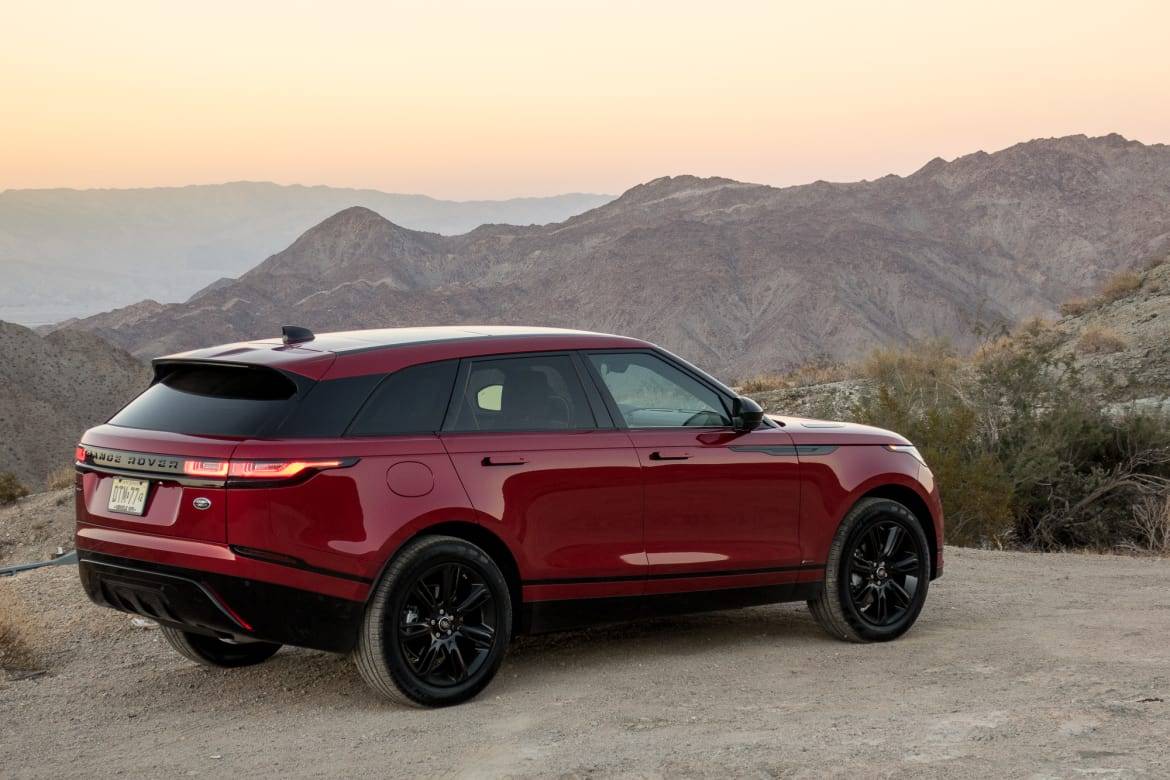
CARS.COM — The 2018 Land Rover Range Rover Velar is the latest entrant into the Land Rover lineup and to my eyes, it is immediately the most beautiful. But does the rest of the package live up to the promise of its looks?
Related: Hands On With Land Rover Range Rover Velar Touchscreens
The name Velar is an homage to prototypes of Land Rover’s very first Range Rover model. Velar was the decoy name splayed across the hood of the car as it underwent testing before its debut as a 1970 model.
- ${price_badge()}
- ${ami_badge()}
- ${battery_badge()}${ev_report_link()}
- ${hot_car_badge()}
- ${award_badge()}
- ${cpo_badge()}
${price_badge_description}
${ami_badge_description}
The EV Battery Rating is based on this vehicle's current expected range relative to the vehicles expected range when new. ${battery_badge_text}
This vehicle is certified pre-owned, backed by a manufacturer warranty, and typically undergoes a rigorous multi-point inspection to ensure quality and reliability.
This vehicle is currently in high demand given its competitive price, desirable features, and overall condition, and may have a higher chance of selling quickly.
Shop the 2018 Land Rover Range Rover Velar near you


The 2018 Land Rover Range Rover Velar is the fourth member of the Range Rover family and it fills a mid-size-SUV hole in Range Rover lineup, slotting in between the Evoque and Range Rover Sport. The Evoque is too small for most SUV applications, while the Sport is too big to be truly city friendly. The Velar represents a Goldilocks middle ground.
I headed to Palm Springs, Calif., to drive three different variants of the Velar, covering the three different engine options. (Per our ethics policy, Cars.com pays for its own transportation and lodging at these events.) Our drive route was a long one, with a mix of highway, mountain roads and a long section of off-road driving.

Powertrains and Suspensions
Land Rover offers three distinct powertrain options on the Velar:
- A 247-horsepower, turbocharged 2.0-liter four-cylinder with 269 pounds-feet of torque; 21/27/23 mpg city/highway/combined
- A 180-hp, turbocharged, 2.0-liter four-cylinder diesel with 317 pounds-feet of torque; 26/30/28 mpg
- A 380-hp, supercharged 3.0-liter V-6 with 332 pounds-feet of torque; 18/24/20 mpg
Each of the engines is mated to an eight-speed automatic transmission and all-wheel drive. The turbocharged four-cylinder gas engine is the only one offered on the base trim level. Each of the other available trim levels (Velar S, SE, R-Dynamic SE and R-Dynamic HSE) will offer buyers their choice of any of the three engines. Land Rover is also producing 500 examples of the Range Rover Velar First Edition, which comes only with the supercharged V-6.
There are two suspension options as well: a standard coil-spring suspension and an air suspension that’s standard with the V-6 and optional on the others. Ground clearance is 8.4 inches with the coil springs, while the air suspension offers adjustable-ride heights. In its normal setting, ground clearance is 8.1 inches but when needed the air suspension can lift the Velar 1.8 inches to offer 9.9 inches of ground clearance at low, off-road speeds. The air suspension also features an access mode that lowers the car by 1.6 inches when the Velar is turned off to make it easier to climb in and out, and load cargo as well.
How It Drives, On Road
I drove all three engines and both suspension options over both highway and mountain roads. Both suspensions offered a comfortable ride on pavement as would be expected of a luxury vehicle; road imperfections were smoothed out and there was a degree of cabin isolation that was much appreciated on a long day in the car.
There were some differences when it came to driving on mountain roads with plenty of elevation changes. In those instances, I preferred the simpler suspension. It felt more composed and did a better job lessening the Velar’s body roll. The Velar isn’t quite what I would call “sporty,” like some other entrants in this class (the Porsche Macan comes to mind), but it has direct, accurate handling and is quite sound dynamically for an SUV.
Among the three engines, it’s a very narrow choice. The V-6 has the most power but gets the worst fuel economy and doesn’t feel particularly quick. The diesel was the best engine for cruising around, but there was a weird lag built into the throttle at all speeds (even with the Velar flipped into Dynamic mode). The gasoline four-cylinder is slightly more responsive than the diesel, but it doesn’t have the same easy low-end power and has a strange whine in the higher rpm range that’s a bit off-putting.
My preference goes slightly toward the diesel, for the fuel economy benefits and all those lovely torques (as the British would call them), but there’s a case to be made for all three.
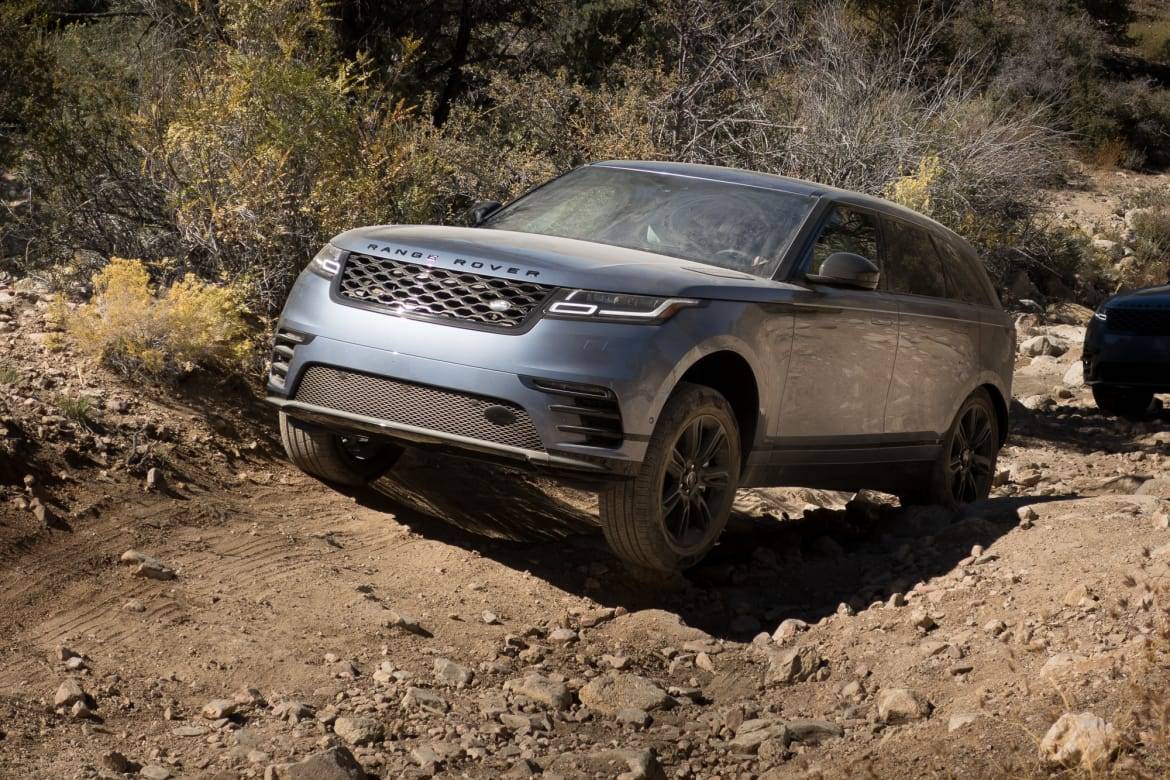
How It Drives, Off-Road
Our driving route also included a couple hours off-road on a desert trail that included some light rock crawling, dirt roads and rocky riverbeds. The only Velar I tested off-road was a V-6-equipped R-Dynamic HSE model that came with the air suspension, active rear locking differential and Terrain Response 2.
All Velars come with regular Terrain Response, which offers a variety of selectable drive modes including several off-road-focused modes like Grass/Gravel/Snow, Mud/Ruts and Sand. On top of that, the optional Terrain Response 2 adds All Terrain Progress Control, which functions like an off-road cruise control. Working in conjunction with the hill descent control system and the traction control, it allows the speed to be set using the cruise control buttons on the steering wheel and it holds the Velar at a constant rate whether going uphill or downhill and over off-road obstacles. It reminded me of a more refined version of Toyota’s crawl control, though less robust and without the unnerving clicking.
The R-Dynamic HSE also comes with 21-inch wheels standard, but our vehicles were dropped down to 20-inch wheels to make them more dexterous off-road. Even with non-aggressive street wheels, the Velar made it up and over rocks, sand and anything else thrown at it — truly impressive to see and feel. As luxurious as the Velar looks and feels on the inside, it still offers significant capability.
With the air suspension fully extended, the ride is rough. Stretching the suspension out to its full height means that the air springs are stiffer, so when driving off-road I’d actually recommend keeping the suspension at normal height unless it needs to be raised to clear obstacles.
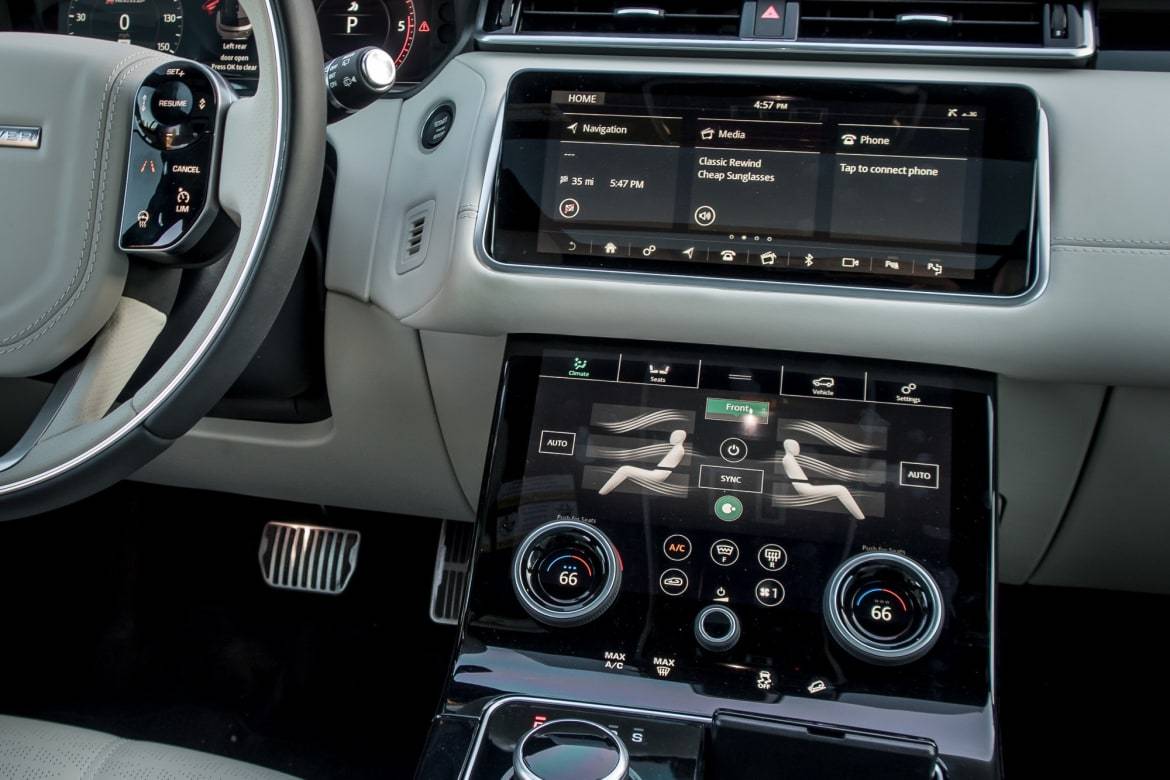
Distracting Screens
The Velar’s interior is styled in a minimalistic, modern fashion thanks to its use of Touch Pro Duo, a standard pair of screens in the center console. I used these screens previously, as well as the optional 12.3-inch digital display in the instrument panel, and my big concern at the time was that they’d be distracting to use while driving.
Unfortunately, that was definitely the case. Performing even simple tasks like adjusting the fan speed while driving required dropping my eyes from the road for a few seconds. And with a new study recently calling out automakers for complicated multimedia systems contributing to distracted driving, it seems like this system would definitely fit in that category.
When I was a passenger, the system was fantastic: On both center screens, the menus are smartly designed, the graphics are clean and easy to read, and the system is responsive to inputs. But while driving on pavement, let alone off-road, it was hard to maintain proper focus while using the various functions.
The same thing could be said for the steering wheel controls that are used to configure the digital instrument panel. The buttons change appearance and functionality depending on what functions you’re currently using; the left thumb, for example, can change volume or the radio station, but hit another button and suddenly it’s used to navigate menus on the display. To look at both the instrument panel and at the controls on the wheel adds another layer of distraction, and there are certain functions that you can control only through those menus.
My suggestion with both these systems would be to set them up before you start driving — if you want the full screen map in the instrument panel, do it while stopped. And if you suspect you’ll want to change the temperature or fan speed, set those functions into the rotary dials while safely stopped so you can change them easily. Or find a friend to drive with all the time to help you out.
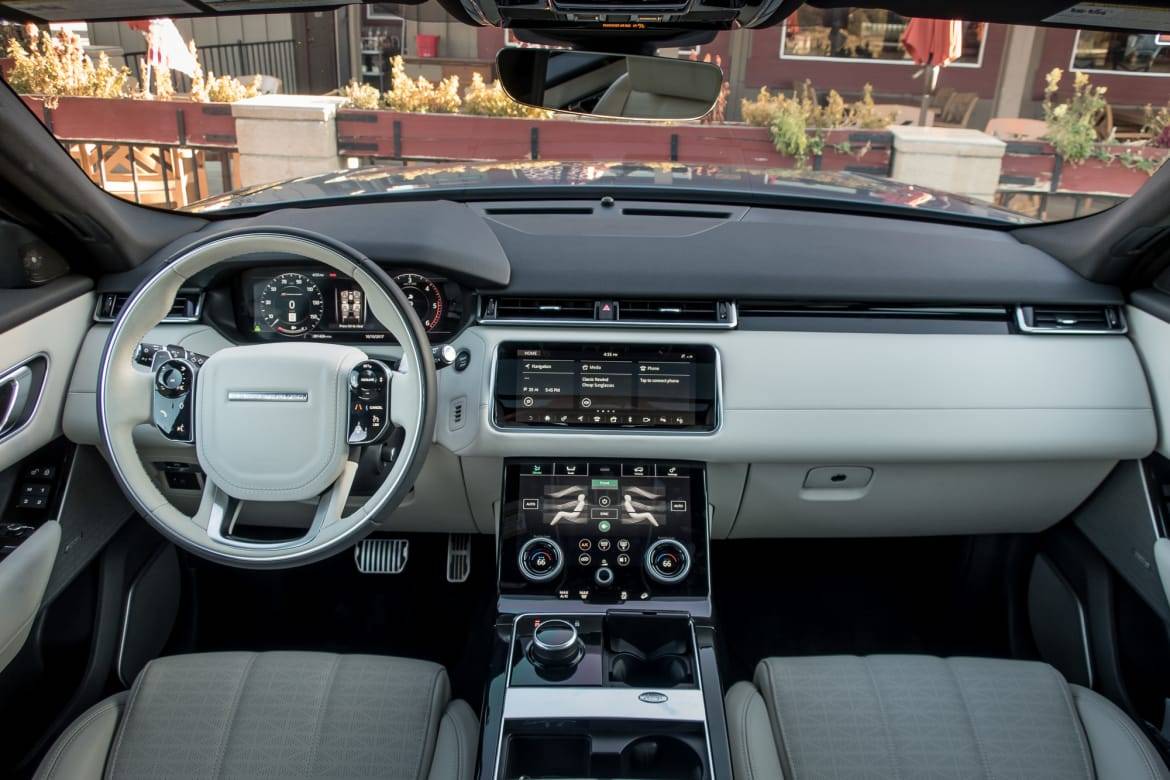
High Quality, High Price
Though the Velar starts at $50,895 (all prices include destination), the price shoots up drastically once the options start adding up. All three of the Velars that I tested were much more expensive than that:
- $74,895, R-Dynamic SE with four-cylinder gas engine
- $75,415, R-Dynamic HSE with four-cylinder diesel engine
- $87,110, R-Dynamic HSE with six-cylinder gas engine
Does the Velar live up to those lofty price tags? I would argue that it does. It definitely has the style to match, inside and out, and it offers a true luxury driving experience with a quiet cabin and comfortable ride.
There aren’t many vehicles around where you can go off-road and get a massage from your seat at the same time. The Velar ably continues the Range Rover cachet of being able to perform in harsh conditions in the most luxurious fashion possible. The only thing giving me pause is that (admittedly beautiful) screen, which is ambitious and over-engineered in the same stroke.
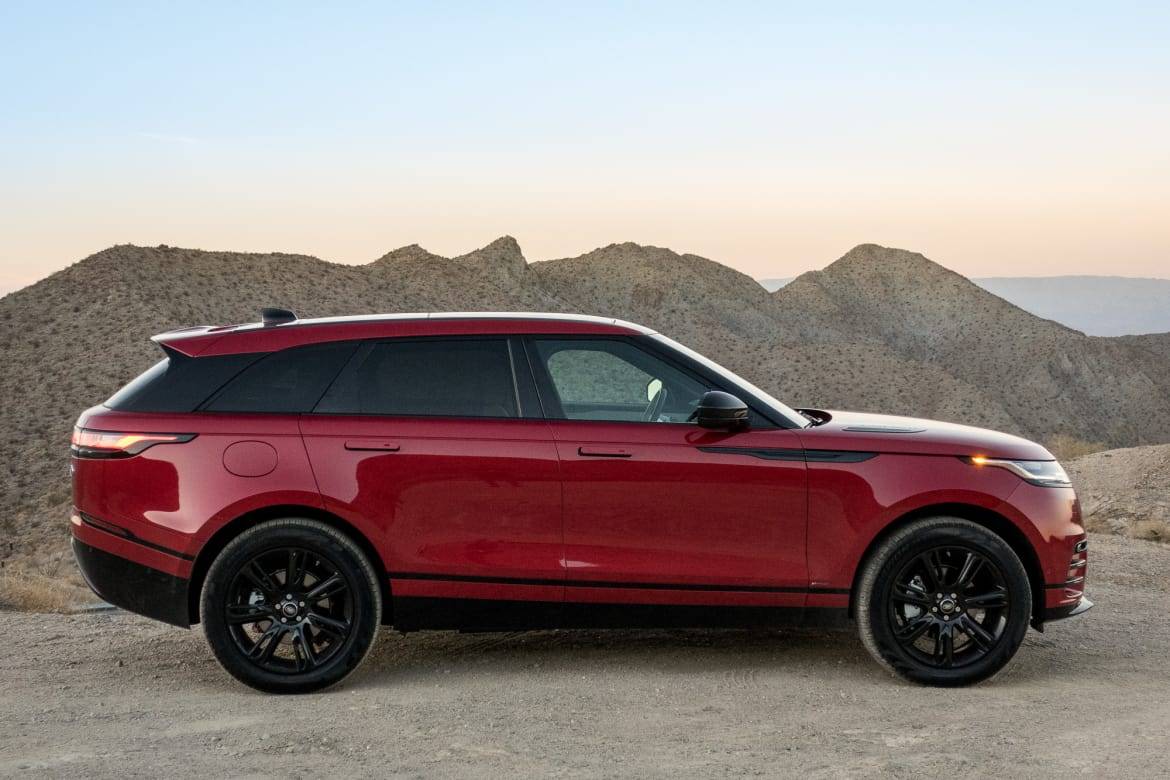

Former L.A. Bureau Chief Brian Wong is a California native with a soft spot for convertibles and free parking.
Featured stories




